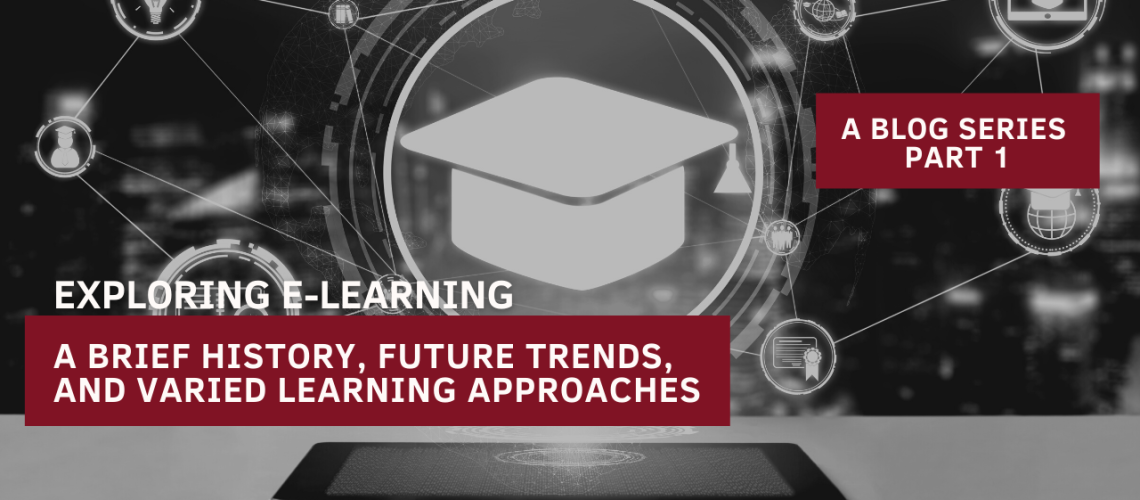By Dr. Salam Slim Saad
Welcome to the exciting world of e-learning, where traditional classrooms are transformed into dynamic virtual learning environments! In today’s fast-paced digital era, education and training have evolved beyond the confines of physical walls. With the advent of technology, we now have endless possibilities to enhance knowledge acquisition and skill development through innovative e-learning design.
Gone are the days when learners had to adhere strictly to rigid schedules or struggle with hefty textbooks. E-learning has revolutionized how we approach education by offering flexible learning opportunities that fit seamlessly into our busy lives. Whether you’re a student seeking interactive courses or an organization looking to train your workforce efficiently, e-learning holds incredible potential for transforming the way we learn.
In today’s rapidly evolving digital landscape, the realm of education has undergone a profound transformation, offering new opportunities and avenues for learning. At the forefront of this educational revolution is e-learning, a dynamic approach that leverages technology to deliver knowledge and skills to learners around the world. In this two-part article series, we embark on a comprehensive exploration of e-learning, starting with Part One, where we delve into the intriguing history, future prospects, and various types of e-learning design.
History of eLearning From Shorthand to Online Education Revolution
E-learning, or electronic learning, has its roots in the emergence of the internet and the subsequent technological advancements that revolutionized communication and information dissemination. From humble beginnings as correspondence courses to the advent of web-based platforms and interactive multimedia, e-learning has continuously evolved to meet the changing needs of learners and educators alike.
The eLearning timeline reflects the remarkable progress made in education through technological advancements. From correspondence courses to online platforms, eLearning has expanded access to education, overcoming barriers of time, location, and circumstances. As technology continues to evolve, the future of eLearning holds great promise, empowering individuals worldwide with lifelong learning opportunities.
- The 1840s: Stenography: In the 1840s, Isaac Pitman, a teacher from Wotton-under-Edge, introduced correspondence-based teaching for shorthand (stenography). Pitman used mail to send assignments and receive completed work for assessment. This method aimed to improve writing speed and gained popularity among professionals like secretaries and journalists.
- From the Automatic Teacher to GLIDER and the Impact of Radio: In 1924, Sidney Pressey, an Educational Psychology Professor at Ohio University, developed the “Automatic Teacher,” a machine resembling a typewriter that facilitated multiple-choice question-based testing. Despite its potential, the Pressey machine failed to gain widespread acceptance due to a lack of interest and investment. In 1954, Harvard professor BF Skinner introduced the “GLIDER,” a teaching machine designed for programmed instruction. Concurrently, radio emerged as a valuable educational tool, with numerous programs covering diverse subjects. Radio and television continued to play pivotal roles in improving education, even during World War II and until the 1960s.
- The 1960s: Computer-Based Education: In the 1960s, computer-based education began to take shape. Daniel Alpert and Don Bitzer developed the Programmed Logic for Automated Teaching Operations (PLATO) at the University of Illinois. Originally designed to improve student literacy, PLATO became a groundbreaking system experimenting with email, message boards, and assessments. It inspired the creation of the eLearning platform Blackboard, marking a pivotal point in online learning history. Stanford professors also utilized computers for teaching math and reading, while online courses were offered by the University of Alberta.
- 1976: Internet-Based Courses and Remote Learning: In 1976, the UK’s Open University pioneered internet-based courses and teleconferencing with the Cyclops whiteboard system. Coastline Community College became the first fully remote community college, while Apple’s collaboration established the Apple Education Foundation, supplying computers and supporting educational software development.
- The 1980s: Personal Computers: The introduction of personal computers, such as Apple’s Macintosh 128K, allowed individuals to access information, learn new skills, and share knowledge through the internet. People began exploring various topics and developing their abilities from the comfort of their homes.
- The 1990s: Learning Management Systems (LMS): In the 1990s, online schools emerged, utilizing Learning Management Systems (LMS) for efficient management of student records, attendance, and assessments. Blackboard, established in 1995, became a prominent LMS provider. The term “eLearning” was coined in 1999, symbolizing computer-based learning and online education advancement.
- The 2000s: Rise of the MOOC: In the 2000s, eLearning evolved with the rise of mobile learning, gamification, and social eLearning. The Massachusetts Institute of Technology (MIT) launched the OpenCourseWare project in 2001, providing educational resources to the public. Platforms like Udemy emerged, offering a vast array of online courses taught by professionals. Social media platforms like Facebook, YouTube, Twitter, and LinkedIn facilitated learning through blogs, videos, and interactive discussions. In 2012, platforms like Coursera, Udacity, and edXintroduced Massive Open Online Courses (MOOCs), marking a significant milestone in online learning.
- The Present: E-Learning in the Age of COVID-19: Since 2020, the COVID-19 pandemic has accelerated the adoption of eLearning. With physical classrooms closed, schools and colleges worldwide turned to online learning to ensure continuity of education. Teachers utilized teaching software to conduct remote classes, highlighting the versatility and advantages of eLearning during times of crisis.
The Different Types of E-learning
When it comes to e-learning, there is no one-size-fits-all approach. In fact, there are several different types of e-learning that organizations can choose from based on their specific needs and goals.
- Asynchronous Online Courses: Asynchronous e-learning refers to self-paced courses that learners can access at any time. The content is usually pre-recorded and delivered through online platforms or learning management systems (LMS). Learners have the flexibility to study at their own pace, accessing course materials, assignments, and assessments at their convenience.
- Synchronous Online Courses: Synchronous e-learning involves real-time interaction between instructors and learners. Classes are conducted through video conferencing tools, webinars, or live chats, where learners can participate, ask questions, and receive immediate feedback. Synchronous courses provide a more interactive experience, simulating a traditional classroom setting.
- Blended Learning: Blended learning combines online and face-to-face instruction. It integrates traditional classroom teaching with e-learning components. Learners engage in both in-person sessions and online activities, such as watching videos, participating in online discussions, or completing assessments. Blended learning offers the benefits of both modes, allowing for flexibility and personalization.
- Massive Open Online Courses (MOOCs): MOOCs are online courses designed for unlimited participation and open access via the internet. They are typically provided by universities, educational platforms, or organizations. MOOCs offer a wide range of subjects and are often free or available at a low cost. Learners can access video lectures, interactive quizzes, discussion forums, and other resources.
- Mobile Learning (M-learning): M-learning refers to e-learning delivered through mobile devices such as smartphones or tablets. It allows learners to access educational content on-the-go, anytime and anywhere. M-learning often utilizes mobile apps, interactive videos, podcasts, or mobile-optimized websites. It provides flexibility and convenience for learners who prefer to study using their mobile devices.
- Microlearning: Microlearning involves delivering educational content in short, bite-sized modules or lessons. Learners can engage with concise and focused materials, typically ranging from a few minutes to 15 minutes in duration. Microlearning is suitable for quick learning, reinforcement of knowledge, or just-in-time learning when learners need specific information or skills.
- Virtual Classrooms: Virtual classrooms simulate a traditional classroom environment in an online setting. Learners and instructors interact through video conferencing tools, collaborative whiteboards, chat features, and other online collaboration tools. Virtual classrooms enable real-time communication, collaboration, and participation, creating a sense of community among learners.
- Virtual Reality (VR) and Augmented Reality (AR): VR and AR technologies offer immersive learning experiences by simulating real-world environments or overlaying digital information onto the physical world. VR creates a completely virtual environment, while AR enhances the real world with virtual elements. These technologies are commonly used in fields such as medical training, engineering, and simulations.
These are just a few examples of the different types of e-learning. The field of e-learning continues to evolve with advancements in technology, and new approaches and strategies are continually being developed to enhance the learning experience.
The Future of E-Learning
As technology continues to advance at a rapid pace, the future of e-learning looks promising. With more and more individuals embracing online education, there is no doubt that e-learning will continue to grow and evolve.
One exciting trend in the future of e-learning is the integration of artificial intelligence (AI) into learning platforms. AI can personalize the learning experience by analyzing data on each student’s strengths and weaknesses, adapting lessons accordingly, and providing targeted feedback. This level of personalization has the potential to revolutionize education as we know it.
Another area that holds great promise for the future of e-learning is virtual reality (VR). VR technology allows learners to immerse themselves in realistic environments, creating an interactive and engaging learning experience. From exploring historical landmarks to conducting complex scientific experiments, VR has the power to bring subjects to life like never before.
Furthermore, mobile learning is expected to play a significant role in the future of e-learning. With smartphones becoming increasingly ubiquitous and internet access expanding globally, learners will have access to educational resources anytime, anywhere. Mobile apps specifically designed for learning purposes are becoming more prevalent and offer convenient ways for students to acquire knowledge on-the-go.
Gamification is set to become even more prevalent in e-learning. By incorporating game elements such as leaderboards, badges, and rewards into educational content, gamification enhances motivation and engagement among learners. It transforms traditional lectures into interactive experiences that make learning fun and enjoyable.
E-learning has come a long way since its inception, offering diverse options for individuals seeking quality education outside conventional classrooms.
As we move forward, it is clear that e-learning will continue to play a crucial role in education and professional development. The flexibility and accessibility it offer make it an ideal choice for learners of all ages and backgrounds. Whether it’s through online courses, mobile apps, or virtual classrooms, e-learning provides endless opportunities for individuals to acquire new knowledge and skills.
I often think about the way I learn best, and how others might learn best. Whether it’s in person, on the internet, through audio or video content, reading an eBook or a hard copy book, there is evidence out there that suggests a mix of all of these will make for the most engaging and effective learning experience possible.
Stay tuned for Part Two of this article series, where we will delve into the benefits and disadvantages of e-learning, as well as provide valuable tips on how to effectively implement e-learning in your organization. In the next part, we will explore the transformative power of e-learning and discuss strategies to overcome any challenges that may arise. So, let’s continue this journey and discover the full potential of e-learning together.
Written By:



